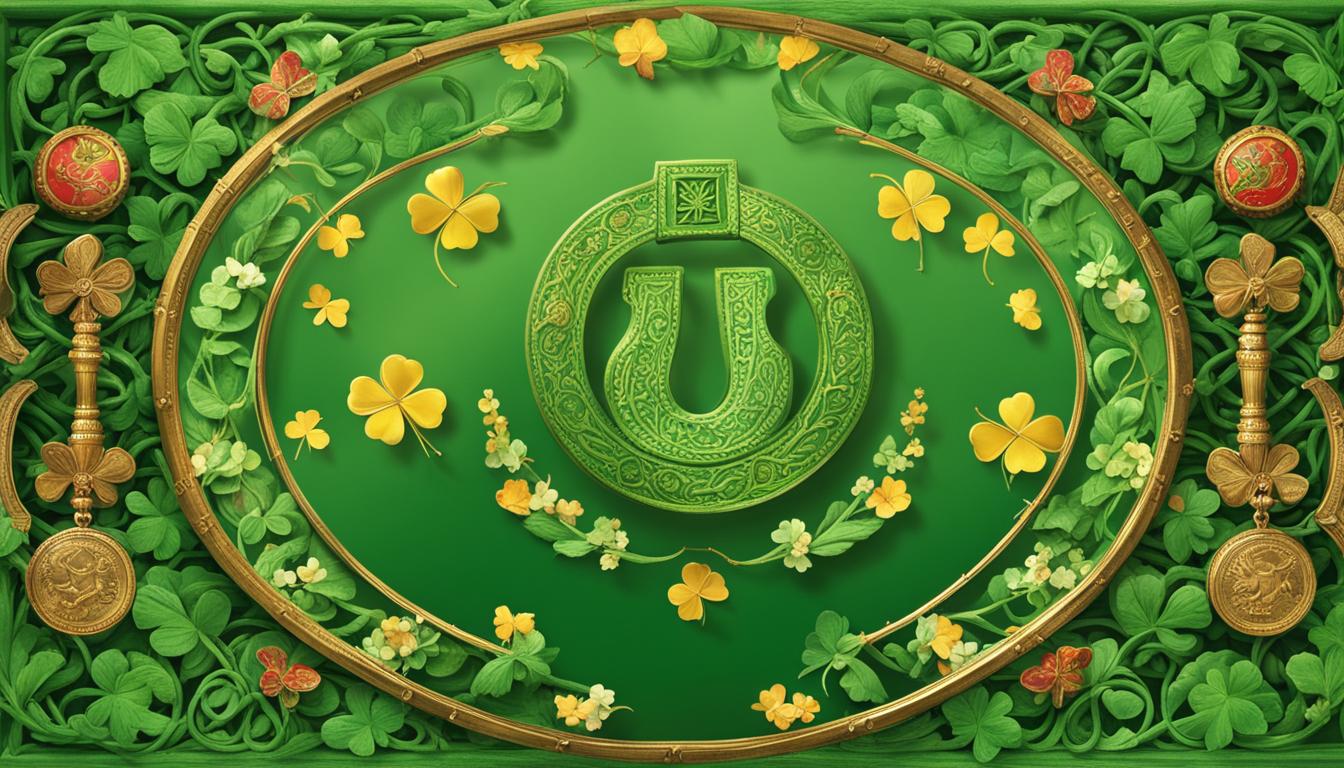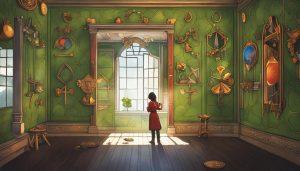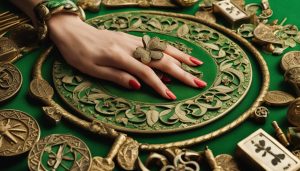Have you ever wondered if the shape of a mirror can bring you good luck? Mirrors have a fascinating history dating back thousands of years and are not only practical but also deeply symbolic. In this article, we will explore the different shapes of mirrors and their association with good fortune. Whether you’re a believer in superstitions or simply curious about the cultural significance of mirrors, get ready to dive into the world of lucky mirror shapes.
Contents
- 1 The History of Mirrors
- 2 The Symbolism of Mirrors
- 3 Mirrors in Superstitions and Beliefs
- 4 Defensive Mirrors in Witchcraft
- 5 Charging Mirrors and Using Them in Spells
- 6 Alternative Mirror: Water
- 7 Conclusion
- 8 FAQ
- 8.1 What shape of mirror brings good luck?
- 8.2 What is the history of mirrors?
- 8.3 What do mirrors symbolize?
- 8.4 Are there any superstitions or beliefs associated with mirrors?
- 8.5 How are mirrors used in witchcraft?
- 8.6 Can mirrors be charged with specific energies?
- 8.7 Can water be used as an alternative to mirrors?
- 8.8 What is the conclusion about mirrors in superstitions and witchcraft?
- 9 Source Links
Key Takeaways
- 1. Mirrors have a long history and are deeply symbolic in various cultures.
- 2. Different shapes of mirrors are believed to bring good luck.
- 3. The superstition of breaking a mirror and bad luck is prevalent in ancient beliefs.
- 4. Mirrors are widely used in interior design for their aesthetic and practical benefits.
- 5. Understanding the symbolism of mirrors can enhance their power in your life.
The History of Mirrors
The history of mirrors dates back to 6000 B.C. when the first mirrors were made of metal and had rounded shapes. These early mirrors allowed people to catch a glimpse of their reflections, although not with the clarity and precision of modern mirrors. It was the Romans who later introduced the creation of glass mirrors, which revolutionized the mirror industry.
However, during Medieval times, the production of glass mirrors diminished due to religious beliefs. Mirrors were considered a vanity item and were associated with sinful behavior. It wasn’t until the 13th century that the production of glass mirrors resumed, and Venetian masters developed flat mirrors, which offered a more accurate reflection.
Today, mirrors are made by adding a thin layer of molten aluminum or silver to glass in a vacuum. This process creates a highly reflective surface that allows us to see ourselves with great detail and clarity. The development of glass and flat mirrors has significantly influenced the way mirrors are used in daily life, from personal grooming to interior design.
Glass Mirrors vs. Flat Mirrors:
| Aspect | Glass Mirrors | Flat Mirrors |
|---|---|---|
| Reflection | Less accurate | Highly accurate |
| Production | Trickier process | Easier process |
| Usage | Common in personal grooming | Preferred in interior design |
| Appearance | Less sleek and modern | Sleek and modern |
“The invention of glass mirrors expanded our ability to see ourselves and our surroundings with greater accuracy, thus transforming our relationship with reflections.” – Mirror historian
The introduction of glass mirrors and later the development of flat mirrors have played a significant role in shaping the reflection capabilities of mirrors. Whether it’s for personal grooming or as decorative elements in interior design, mirrors have become an essential part of our lives, allowing us to see ourselves and the world around us in more detail than ever before.
The Symbolism of Mirrors
Mirrors hold deep symbolism, representing various facets of human nature and perception. They are often associated with truth, wisdom, self-reflection, and vanity. The reflection we see in a mirror can reveal not only our physical appearance but also the deeper aspects of our true selves. Mirrors serve as windows to the depths of our soul and mind, reflecting who we truly are beneath the surface.
While mirrors are often seen as instruments of self-discovery, they can also be deceiving. Curved or distorted mirrors alter reality and can represent the duality of truth and illusion. The superstition of breaking a mirror and bringing bad luck stems from the belief that mirrors reflect the soul. When a mirror shatters, it is thought to trap the soul within its fragmented pieces.
Mirrors are not only a reflection of your physical appearance, but a glimpse into the core of your being. They hold the power to reveal your true self and reflect the truths that lie within.
Throughout history, mirrors have played a significant role in various cultural beliefs and superstitions. In ancient Greek and Chinese traditions, breaking a mirror is believed to bring seven years of bad luck. This association with misfortune stems from the belief that the soul is connected to one’s reflection, and shattering a mirror can sever that connection.
The Symbolism of Mirrors in Different Cultures
The symbolism of mirrors extends beyond individual interpretation and can vary across different cultures. In some cultures, mirrors are used as tools for divination and communication with the spiritual realm. Native American tribes, for example, believe that mirrors can reveal one’s true intentions and help connect with ancestors.
In Japanese folklore, mirrors hold spiritual significance and are believed to possess the power to attract good fortune and ward off evil spirits. They are often found in shrines and used in various rituals.
| Culture | Mirror Symbolism |
|---|---|
| Greek | Reflection of the soul Superstition of broken mirrors |
| Chinese | Reflection of the soul Superstition of broken mirrors |
| Native American | Connection with ancestors Revealing true intentions |
| Japanese | Attracting good fortune Warding off evil spirits |
Mirrors continue to intrigue and inspire, both in the realm of superstitions and as powerful symbols of self-discovery. Whether we view mirrors as portals to our inner selves or as reflective surfaces, they remind us that perceptions can be both revealing and deceiving.
Mirrors in Superstitions and Beliefs
The use of mirrors has been intertwined with superstitions and beliefs for centuries. One of the most well-known superstitions is that breaking a mirror brings seven years of bad luck. This belief can be traced back to ancient astrological beliefs and the association of mirrors with the reflection of the soul. The moon’s reflective qualities also play a role in this superstition.
Superstitions surrounding mirrors vary across cultures. In some, breaking a mirror is believed to bring death to the household or to be an omen of impending misfortune. These beliefs are often influenced by astrological concepts and the idea that planetary alignments can have a significant impact on one’s life. Additionally, omens and signs from nature are often considered when determining the level of luck associated with a broken mirror.
While superstitions surrounding mirrors may seem irrational to some, they hold deep cultural significance and are still widely believed and feared by many. Whether it be avoiding breaking mirrors or taking precautions to ward off bad luck, these beliefs continue to shape the way mirrors are viewed and treated in various societies.
“A broken mirror is said to trap the soul inside, causing seven years of bad luck. It’s a fascinating superstition that highlights the deep connection between mirrors and our perception of the soul.” – Cultural Beliefs and Superstitions, Mirror Magic
The Impact of Superstitions on Mirror Handling
Superstitions about mirrors have influenced the way people handle and interact with them. It is not uncommon for individuals to exercise caution when moving mirrors or to cover them during transportation to avoid accidentally breaking them. Some people also take measures to protect mirrors from damage, such as using soft cloth covers or positioning them in safe locations where they are less likely to be bumped or knocked over.
These beliefs have also led to the development of various rituals and practices aimed at warding off bad luck associated with broken mirrors. Some people may perform cleansing or protection rituals, such as lighting candles or using crystals, to cleanse the energy of a mirror or protect it from negative influences.
| Superstition | Belief |
|---|---|
| Breaking a Mirror | Brings seven years of bad luck |
| Covering Mirrors at Night | Prevents spirits from entering the house |
| Warding off Evil Spirits | Placing mirrors facing outwards to reflect negative energy |
| Mirrors in the Bedroom | Invites a third person into the relationship |
| Breaking a Mirror While Looking at Yourself | Causes a soul to be trapped inside the mirror |
Defensive Mirrors in Witchcraft
In the realm of witchcraft, mirrors serve a purpose beyond mere reflection. They possess an inherent power that can be harnessed for defensive practices. Defensive mirrors are widely utilized in binding spells, offering a means to confine and control energies. By placing a target’s name between two mirrors, a potent binding is formed, effectively restraining their influence.
Protective mirrors also find a place on altars, serving as a shield against malevolent spells and intentions. These mirrors can be charged with specific energies, imbuing them with a heightened defensive aura. Some practitioners choose to paint sigils and protection runes onto the mirrors, further enhancing their protective qualities.
“By incorporating defensive mirrors into your craft, you can establish a potent barrier of energy, warding off negative forces and repelling unwelcome influences,” explains experienced witch and spellcaster, Selene Moonshadow.
Altar mirrors, specifically crafted for spiritual practices, are revered for their ability to reflect truths, both seen and unseen. These mirrors offer a glimpse into the hidden aspects of a situation, illuminating the intentions and energies at play. As such, they are invaluable tools in divination and spellwork, enabling practitioners to make informed decisions and take the necessary precautions.
The Power of Defensive Mirrors in Witchcraft
Defensive mirrors hold a significant place in the world of witchcraft, allowing practitioners to harness their energy for protective purposes. Whether used in binding spells, crafted as altar mirrors, or charged with specific energies, these mirrors serve as formidable instruments of defense in the witch’s arsenal.
| Defensive Mirrors | Binding Spells | Protective Mirrors | Altar Mirrors |
|---|---|---|---|
| Confine and control energies | Place target’s name between two mirrors | Imbued with specific energies | Reveal hidden aspects of a situation |
| Powerful barriers against negative forces | Formidable shields against malevolent spells | Painted with sigils and protection runes | Useful tools for divination and spellwork |
| Repel unwelcome influences | Provide insights and informed decisions |

Charging Mirrors and Using Them in Spells
Mirrors can be powerful tools for practitioners of magic, as they have the ability to trap and amplify energy. By charging mirrors with specific energies, you can harness their power and use them effectively in your spells and rituals.
One way to charge a mirror is by leaving it in a location that corresponds to the energy you want to imbue it with. For example, if you want to enhance your intuition, you can place the mirror near your meditation space or on your altar while performing divination rituals. Over time, the mirror will absorb the energy of the surrounding environment, making it a potent tool for your magical workings.
When using mirrors in spells, they can be strategically placed to amplify the magic being performed. By reflecting and redirecting energy, mirrors can intensify the effects of your spellwork. For instance, if you’re casting a love spell, you can position a mirror to reflect the energy back onto the intended target, increasing its potency. Remember to always use mirrors responsibly and with pure intentions, as they have the power to magnify both positive and negative energies.
Additionally, breaking mirrors can hold significance in certain spells and rituals. Breaking a mirror is often seen as a symbol of breaking through obstacles or breaking old patterns. The shattered pieces can be incorporated into self-altering rituals, representing the breaking of limitations and the transformation of one’s self. However, it is important to approach mirror-breaking rituals with caution and respect, as this practice carries both symbolic and energetic weight.
| Charging Mirrors | Using Mirrors in Spells | Breaking Mirrors in Spells |
|---|---|---|
| Leave mirrors in locations with desired energies | Strategically position mirrors to amplify magic | Breaking mirrors can symbolize breaking through or breaking old patterns |
| Imbues mirrors with specific energies over time | Reflect and redirect energy to intensify spellwork | Shattered mirror pieces can be used in self-altering rituals |
| Enhances the power of mirrors as magical tools | Use responsibly and with pure intentions | Approach mirror-breaking rituals with caution and respect |
Alternative Mirror: Water
While mirrors are commonly used for scrying and divination, water can serve as an intriguing alternative. Water scrying, also known as hydromancy, involves gazing into a smooth body of water, such as a bowl or a reflecting pool, to seek insights and answers from beyond. The calm and reflective surface of the water acts as a mirror, allowing for the visualization of images and symbols that hold significance.
Water scrying has been practiced for centuries in various cultures around the world. Its use in divination stems from the belief that water is a conduit for spiritual energy and that its smooth surface can provide a window into the metaphysical realm. By focusing on the water and allowing the mind to relax, individuals can tap into their intuition and receive guidance from the subtle vibrations and energies present in the water.
“Water scrying allows you to connect with your subconscious mind and the collective unconscious to gain insight and understanding,” says renowned diviner, Eliza Moonstone.
To engage in water scrying, fill a shallow bowl with clean water and find a quiet, comfortable space. Dim the lights and place the bowl in front of you. Take a few deep breaths to center yourself and clear your mind. Gaze into the water, allowing your eyes to focus on its surface. Be open to any thoughts, images, or sensations that come to you. Take note of anything significant that you see or feel during the scrying process, as these may hold messages from the spiritual realm.
| Pros of Water Scrying | Cons of Water Scrying |
|---|---|
|
|

The Versatility of Water in Divination
Water has long been regarded as a powerful medium for spiritual and mystical practices. In addition to water scrying, it can be used in various divination methods, such as water dowsing and water gazing. Water dowsing involves using a pendulum or divining rod over a body of water to obtain answers or locate hidden objects. Water gazing, similar to water scrying, involves focusing on the reflections and ripples in water to gain insights, guidance, and even prophetic visions.
As with any form of divination, it’s important to approach water scrying with an open mind and a respectful attitude. Take the time to develop your own personal connection with water as a divination tool, and experiment with different techniques and rituals to enhance your experience. Remember, the messages and guidance received through water scrying are unique to each individual, so trust your intuition and embrace the journey of self-discovery that water scrying can offer.
Conclusion
Throughout history, mirrors have held a deep significance in cultures worldwide. From their symbolism of truth, wisdom, and self-reflection to the superstitions and beliefs surrounding them, mirrors have played a prominent role in our lives.
In the realm of witchcraft, mirrors take on a new dimension. They serve as powerful tools for defense, amplifying magic, and trapping energies. By charging mirrors with specific energies and incorporating them into spells, practitioners can harness their transformative energy and enhance their craft.
However, mirrors are not the only medium for divination and scrying. Water, with its smooth surface, can act as an alternative mirror. Water scrying offers a unique approach to seeking insights and answers. It can also be used to trap and enhance energies, making it a versatile tool for those who prefer water over traditional mirrors.
In conclusion, whether you embrace the superstitions and beliefs associated with mirrors, or use them as powerful instruments in your craft, mirrors have a significant impact. They invite self-reflection, offer protection, and amplify the magic within. So go ahead, explore the mystical world of mirrors, and let their enchanting power guide you on your spiritual journey.
FAQ
What shape of mirror brings good luck?
The shape of a mirror does not determine good luck. The superstition of breaking a mirror and bringing bad luck has nothing to do with the shape of the mirror itself.
What is the history of mirrors?
Mirrors have a long history dating back to 6000 B.C. The first mirrors were rounded and made of metal. The Romans later created the first glass mirror. Glass mirrors disappeared during Medieval times due to religious beliefs but were reintroduced in the 13th century.
What do mirrors symbolize?
Mirrors symbolize truth, wisdom, self-reflection, and vanity. They reflect our physical appearance and can also represent a reflection of our true selves underneath the surface.
Are there any superstitions or beliefs associated with mirrors?
Yes, there is a superstition that breaking a mirror brings seven years of bad luck. This belief stems from ancient Greek and Chinese beliefs where mirrors were associated with the soul. Other cultures have their own beliefs regarding mirrors and bad luck.
How are mirrors used in witchcraft?
Mirrors can be used in witchcraft for defensive purposes, such as binding spells or as protective tools on altars. They can be charged with specific energies and used to detect harm or show a person’s true intentions.
Can mirrors be charged with specific energies?
Yes, mirrors can be charged with specific energies by leaving them in different locations associated with that energy. The trapped energy can be used in spells, meditation, or enhancing dreams.
Can water be used as an alternative to mirrors?
Yes, water can be used as an alternative to mirrors for scrying and divination. Water’s smooth surface acts as a mirror and can conduct energies well.
What is the conclusion about mirrors in superstitions and witchcraft?
Mirrors have a rich history and symbolism across different cultures. They have been associated with superstitions and beliefs, and they are commonly used in witchcraft for defensive purposes and enhancing magical practices.






